Gibson + Recoder: Projection Performance for Single and Dual 16mm Film Projection
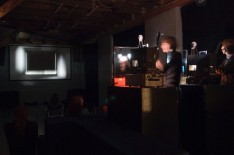
Gibson + Recoder performing Backlight
Los Angeles Filmforum presents
Gibson + Recoder: Projection Performance for Single and Dual 16mm Film Projection
Sunday September 21, 2025, 7:30 pm
At 2220 Arts + Archives, 2220 Beverly Blvd., Los Angeles CA 90057
Tickets: $15 general, $10 students/seniors, free for Filmforum members
Link: https://link.dice.fm/da23cc096a89
Sandra Gibson and Luis Recoder have created one of the most sustained and sophisticated treatments of film of their generation. Rather than being wrapped in nostalgia or irony, their work is refreshingly direct in characterizing celluloid as a material that does not fit into a singular path through the projector and is not dedicated only to creating a cinematic representation of the world. – John Hanhardt, “The End(s) of Film”
“Gibson + Recoder make what is normally called expanded cinema, though a better term for what we’re going to see tonight might be “reduced” cinema. I think it was Michael Snow who once said that all you need to make a movie is duration and a beam of light, implying that cinema could exist without traditional images entirely. Our commonsense notion is that cinema is comprised of moving pictures, but there was a moment in the late 1960s and early 70s when critical thought about cinematic specificity really crystallized. From then on, “cinema” came to designate more than just moving images; it meant a certain kind of space and context for the reception of those images, and one now had to account for the layout of the auditorium, the placement of the projector behind the audience, and the screen that catches the beam of light and arrests its trajectory in order to make the image visible at all. This would also mean that the audience, seated between the projector and the screen, is itself caught up in the medium and an integral part of its functioning. Whether this idea emerged in the experiments of structural filmmakers like Snow, Frampton, and Ernie Gehr, or in film theory’s new turn toward “the apparatus” in classic texts by Baudry, Metz and Stephen Heath, clearly there was a new awareness of cinema as a complex medium with its own internal logic. Unfortunately, according to Rosalind Krauss, this was also around the same time that the Portapak video camera became popular with artists and smashed that modernist dream of specificity into little pieces.
“Gibson + Recoder began collaborating in 2000 and naturally they inherit the ambiguity of that legacy. On the one hand, they often try to take cinema back to its essentials as a space in which light and movement are projected on a flat surface, and they continue the structural-materialist tradition of making visible those aspects of the movies that we see and yet don’t see—the purely phenomenological impact of light and movement and color and sound, or the auditorium as a particular disposition of human bodies in architectural space. At the same time, they are unafraid to take their work into the art gallery as installation or sculpture, and the gallery, as we know, is a space with very different conventions of time management. Nor are they wedded to the analog projector as the end-all be-all of film art, and they have begun to experiment with DCP—as they did at the 2014 Oberhausen film festival, where they projected a random narrative film through rotating glass objects to make, as Erika Balsom put it in Artforum, an “ectoplasmic blur…that created abstract, gaseous images at times recalling 19th century spirit photography”; then the artists forced the audience to move back and forth between separate theaters every 20 minutes, in homage to the idea of the reel changeover in standard, pre-platter theatrical projection systems. Above all, they are most interested in the projector itself as a machine with certain capabilities and attributes, including ones that are often hidden away as disturbing to the cinematic experience, such as light spill, internal cooling systems, or just the simple fact that a projector can be turned on and off in rhythmic alternation. They explore the ways in which the projector’s seemingly mechanical features are always already metaphors for seeing and thinking” - Seth Watter
Film in its analog format is nothing without the art of projection, whereas the latter can do without the former. In this program of 16mm film performances for single and dual projection, film is not the exclusive object of attraction but the occasion for potentially disclosing the art of projection. The “performance” in our title refers to the success or failure of the film to articulate the beauty of projected light on a screen. The works in this program include the following: Still Succession, Alignments for Linea, Lightline, Corner Film, and others. Total running time: approx. 70 mins.
Gibson + Recoder have exhibited their work at the Whitney Museum of American Art, Mad. Sq. Art, REDCAT, Wexner Center for the Arts, Ballroom Marfa, The Kitchen, Light Industry, FiveMyles, Anthology Film Archives, San Francisco Cinematheque, Berkeley Art Museum and Pacific Film Archive, Conversations at the Edge, Walter and McBean Galleries, Memorial Art Gallery, Young Projects Gallery, Robischon Gallery, Microscope Gallery, I-Park Foundation, Exploratorium, Sundance Film Festival, National Gallery of Art, Artefact Festival, Bozar, M HKA, HMKV, Viennale, Austrian Film Museum, Metro Kinokulturhaus, Internationale Kurzfilmtage Oberhausen, International Film Festival Rotterdam, La Casa Encendida, Serralves Foundation, Museu do Chiado, Solar Galeria de Arte Cinemática, and EYE Film Museum. They live and work in New York.
Special thanks to Holly Willis and USC.
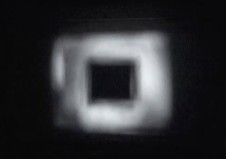
Backlight
Backlight
2006, Doubled 16mm film projection performance, black/white, sound or silent, variable duration (approx. 15–20 minutes).
“The function of the motion-picture screen is to display a world of fantasy and entertainment without the screen being obvious.”
- From “Screen Masking, Surrounds, and Screen Draperies” in Motion-Picture Projection and Theatre Presentation Manual, ed. Don V. Kloepfel (5th edition, 1992)
The point of departure for this projection performance is the obliteration, literally the blotting-out, of the cinematic object of projection. Projection performance as the art par excellence of obstructing, concealing, masking absolutely nothing but itself; in which the spectacle of the apparatus is to be screened, or better screened-out, in the negative relief of a self-cancellation vis-à-vis nothing but the disciplinary application of a cinematic standard.
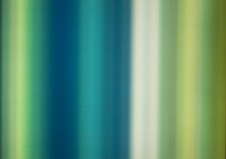
Lightline
Lightline
2011, 16mm film, color, silent or sound, 12 minutes.
Lightline is a “prepared projection” work in which the intermittent mechanism of a regular 16mm projector has been disengaged, thereby allowing the filmstrip to slide uninterruptedly through the gate and pressure plate assembly. The verticality of the filmstrip’s passage through the projector is the subject matter of the work, emphasized not only be the absence of intermittent motion which normally arrests the filmstrip into so many frames-per-second, but also by the placement of a Plexiglas cylinder directly in front of the lens, thus elongating and stretching the light source. A found film reel from an undisclosed feature-length movie has been selected for this prepared projection set-up primarily for its cinematic composition of color and movement. Cinematographic movement (i.e., movement of the camera) and any movement within the frame are completely transformed into an ever-changing cascade of multicolored vertical bands moving horizontally back-and-forth across the screen.
For the installation version of Lightline see Reset The Apparatus website:
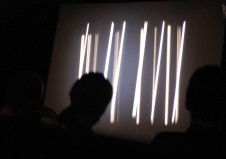
Alignments for Linea
Alignments for Linea
2003, Double 16mm film projection performance, black/white, sound, variable duration (approx. 15–20 minutes).
Music by Charlemagne Palestine: Schlingen-Blängen (1979/1999)
Alignments for Linea is a site-sensitive projection performance. Intermittent machine-precision line scratches on black opaque film provide the basis for this dual projection performance. The “performance” consists in an open set of carefully choreographed projector movements, including the alignment-misalignment-realignment in the distribution of the projected light or light incisions across the screen. Micro adjustments in the optical bending and diffraction of light introduce an uncanny sense of mobility that seems to transcend the fixed parameters of the loop form.
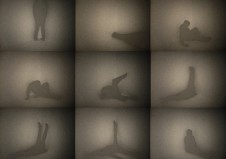
Corner Film
Corner Film
2019, 16mm film, black/white, silent, 11 minutes.
The 2018 film document of Douglas Dunn’s Corner Dance (1972) for solo dancer, performed by the choreographer in a freestanding corner installed at his studio loft in SoHo was shot on 400 ft. of expired 16 mm color negative film stock with a 100 ft.–capacity spring-driven hand-cranked Bolex H-16 Reflex camera. A black-and-white work print was struck from the color negative. The length of each shot was determined by the camera’s fully wound spring-driven mechanism, allowing for a maximum length of approximately 18 ft. of film to advance, i.e., 28 seconds at 24 fps (frames per second). This purely mechanical feature shares a curious affinity to the intervallic choreography of Dunn’s corner tableaux, of which there are a total of eighteen static poses interspersed with an equal number of transitional movements from pose to pose. By chance the number of poses coincided with the number of shots distributed across the 400 ft. roll of film. Eighteen shots structurally preserves the basic choreographed score of eighteen movements. What is not captured in the film document is the exponentially diminishing duration from pose to pose determined by a breath count system so that the first pose is held for twenty deeper-than-normal breaths, the second pose for nineteen breaths, and so on. The filmic analogue for the rhythmic and temporal register of “breath” is perhaps marked by the intermittent automatism of the 24 fps filmstrip document, rendered visible in the metrical notation of frameline spacing and the abrupt jump-cut flash frame at the end and beginning of each shot. - Excerpt from Corner: Gibson + Recoder / Douglas Dunn (MAB Books, 2019): https://www.miltonartbank.com/mabbooks/p/corner
